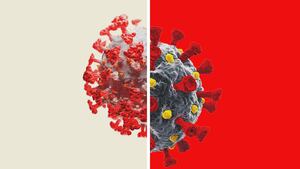All over the world, the rates of death and hospitalization from COVID keep dropping. But our successful mitigation of the worst outcomes of the 33-month-old pandemic belie a growing crisis.
More and more people are surviving COVID and staying out of the hospital, but more and more people are also living with long-term symptoms of COVID. Fatigue. Heart problems. Stomach problems. Lung problems. Confusion. Symptoms that can last for months or even a year or more after the infection clears.
As many as 21 percent of Americans who caught the SARS-CoV-2 virus this summer ended up suffering from long COVID starting four weeks after infection, according to a new study from City University of New York.
That’s up from 19 percent in figures the U.S. Centers for Disease Control and Prevention reported in June.
Compare those numbers to the recent rates of death and hospitalization from COVID in the U.S.—three percent and .3 percent, respectively. Long COVID is by far the likeliest serious outcome from any novel-coronavirus infection. And possibly getting likelier.
The CUNY study, which is not yet peer-reviewed, focused on American adults, but the results have implications for the whole world. Globally, long-term symptoms are partially replacing COVID deaths. After all, more COVID survivors means more people at risk of long-term symptoms. And long COVID is cumulative—people get sick and stay sick for a while.
“Despite an increased level of protection against long COVID from vaccination, it may be that the total number of people with long COVID in the U.S. is increasing,” epidemiologist Denis Nash, the CUNY study’s lead author, told The Daily Beast. That is, every day more people catch long COVID than recover from long COVID.
But understanding long COVID, to say nothing of preventing it, isn’t a priority in the global epidemiological establishment. That needs to change, Nash said. “I believe it is long past time to be focusing on long COVID in addition to preventing hospitalizations and deaths.”
In recent weeks, authorities have logged around half a million new COVID cases a day, worldwide. That’s not quite as low as the 400,000 new cases a day health agencies tallied during the biggest dip in case-rates back in February 2021. But it’s close.
What’s really remarkable, however, is how few of those half-a-million-a-day COVID infections are fatal. Lately, just 1,700 people have been dying every day—that’s a fifth as many died daily in February last year, when the number of new infections every day was only slightly greater.
Hospitalizations for serious COVID cases are down, too. Global statistics aren’t available, but in the U.S., COVID hospitalizations dropped from 15,000 a day 19 months ago to just 3,700 a day now.
It’s not hard to explain the decrease in the death and hospitalization rates. Worldwide, around two-thirds of adults are at least partially vaccinated. Billions of people also have antibodies from past infections they survived. Every antibody helps to blunt the absolutely worst outcomes.
But the incidence of long COVID appears to be ticking upward. The high reinfection rate could be one reason. Currently, one in six people catches the virus more than once. Repeated infections come with elevated risk of a whole host of problems that, not coincidentally, match the symptoms of long COVID, a team of scientists at Washington University School of Medicine and the U.S. Veterans Administration's Saint Louis Health Care System concluded in a study this summer. The more reinfections, the more long COVID.
Crunching the numbers from back in July, Nash’s team concluded that 7 percent of all American adults—that’s more than 18 million people—had long COVID at the time. If the same rate applies to the whole world—and there’s no reason to believe it doesn’t—the global caseload for long COVID could’ve exceeded 560 million this summer.
That number is probably a lot higher now, considering the summer spike in infections resulting from BA.5—a million worldwide new cases a day in July.
One thing that surprised Nash and his teammates is that the risk of long COVID isn’t uniform across the population. Young people and women are more likely to catch long COVID, the CUNY team found. Nash said the higher vaccination rate among older adults and seniors could explain the former. But the latter remains a mystery. “Further study of these groups may provide some clues about risk factors,” he said.
Why there’s a sex gap in long COVID risk is just one unanswered question that scientists and health officials could be trying to answer. They could also be working up new vaccine strategies and public-health messaging specifically for long COVID.
But by and large, they’re not doing much to address the risk of long-term symptoms, Nash said. Nearly three years into the COVID pandemic, authorities are still overwhelmingly focused on preventing hospitalizations and deaths—and only preventing hospitalizations and deaths.
“Exclusively focusing on these outcomes could arguably make the long COVID situation worse,” Nash explained, “since there is a substantial amount of long COVID among people that have only had mild or less severe SARS-CoV-2 infections.”
In that sense, long COVID is a silent crisis. One that affects potentially more than half a billion people, but which isn’t a major focus of research or public health policy. “It’s certainly valuable to save lives, but quality of life is very important, too—and that can be lacking in people who have long COVID,” Cindy Prins, a University of Florida epidemiologist, told The Daily Beast.
We’re not powerless to prevent long COVID, of course. The same tools that can prevent hospitalization and death from COVID can also reduce the likelihood of long-term symptoms—all by lowering the chance of any COVID, short or long. Get vaccinated. Keep current on your boosters. Mask up in crowded indoor spaces.
But given the trend in SARS-CoV-2’s evolution, long COVID could become a bigger and bigger problem even among the most careful people—and a problem begging for specific solutions. The virus is still mutating. And every new variant or subvariant has tended to be more contagious than the last, meaning more and more breakthrough infections in the fully-vaccinated and boosted.
If you’re currently up to date on your jabs, the chances of COVID killing you or putting you in the hospital are low. But the chances of it making you sick, potentially for a very long time, are substantial—and apparently getting higher.







